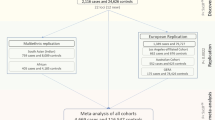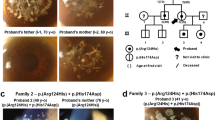Abstract
The two most common autosomal dominant dystrophies of the corneal stroma are lattice corneal dystrophy type I and granular dystrophy. A third autosomal dominant stromal dystrophy (Avellino) has also been recognized. Chromosome linkage analysis of four families with Avellino dystrophy mapped the disease–causing gene to chromosome 5q. Subsequent linkage analysis of two families with typical lattice dystrophy and two with typical granular dystrophy also revealed significant linkage with the same markers. Thus, each of three clinically and histopathologically distinct phenotypes is independently linked to 5q. The maximum combined lod score using all 114 affected patients was 28.6 with marker D5S393. None of the 14 known human amyloid–associated genes map to chromosome 5.
This is a preview of subscription content, access via your institution
Access options
Subscribe to this journal
Receive 12 print issues and online access
$209.00 per year
only $17.42 per issue
Buy this article
- Purchase on Springer Link
- Instant access to full article PDF
Prices may be subject to local taxes which are calculated during checkout
Similar content being viewed by others
References
Midura, R.J. et al. Proteoglycan biosynthesis by human corneas from patients with types 1 and 2 macular corneal dystrophy. J. biol. Chem. 265, 15947–15955 (1990).
Meretoja, J. Familial systemic paramyloidosis with lattice dystrophy of the cornea, progressive cranial neuropathy, skin changes and various internal symptoms. Ann. din. Res. 1, 314–324 (1959).
de la Chapelle, A. et al. Gelsolin-derived familial amyloidosis caused by asparagine or tyrosine substitution for aspartic acid at residue 187. Nature Genet. 2, 157–160 (1992).
Jones, S.T. & Zimmerman, L.E. Histopathologic differentiation of granular, macular and lattice dystrophies of the cornea. Am. J. Ophthal. 51, 394–410 (1961).
Folberg, R. et al. Clinically atypical granular corneal dystrophy with pathologic features of lattice-like amyloid deposits: A study of three families. Ophthalmology 95, 46–51 (1988).
Holland, E.J. et al. Avellino corneal dystrophy: Clinical manifestations and natural history. Ophthalmology 99, 1564–1568 (1992).
Rosenwasser, G. et al. Phenotypic Variation in Combined Granular/Lattice (Avellino) Corneal Dystrophy. Arch. Ophth. 111, 1546–1552 (1993).
Jacobson, D.R. & Buxbaum, J.N. Genetic aspects of amyloidosis. Adv. hum. Genet. 20, 69–123 (1991).
Hsiao, K.I. et al. Mutant prion proteins in Gerstmann-Straussler-Scheinker disease with neurofibrillary tangles. Nature Genet. 1, 68–71 (1992).
Hsiao, K. et al. Mutation of the prion protein in Libyan Jews with Creutzfeldt-Jakob disease. New Engl. J. Med. 324, 1091–1097 (1991).
Medori, R. et al. Fatal familial insomnia, a prion disease with a mutation at Codon 178 of the prion protein gene. New Engl. J. Med. 326, 444–449 (1992).
Tagliavini, F.R. Giaccone, G., Verga, L., Ghiso, J., Frangione, B., Buglanni, O. Alzheimer patients: Preamyloid deposits are immunoreactive with antibodies to extracellular domains of the amyloid precursor protein. Neurosci. Lett. 128, 117–120 (1991).
Sipe, J.D., Ann. Rev. Biochem. 61, 947–975 (1992).
Dwelet, F.E. & Benson, M.D. Primary structure of an amyloid pre-albumin and it plasma precurson in a heredofamilial polyneuropathy of Swedish origin. Proc. natn. Acad. Sci. U.S.A. 81, 694–698 (1984).
Johnson, K.H., O'Brien, T.D., Betsholtz, C. & Westermark, P. Islet amyloid, islet amyloid polypeptide, and diabetes mellitus. New Engl. J. Med. 321, 513–518 (1989).
Kluve-Beckerman, B. et al. Localization of human SAA gene(s) to chromosome 11 and detection of DNA polymorphisms. Biochem. biophys. Res. Commun. 137, 1196–1204 (1986).
Sletten, K. & Westermark, P. Characterization of molecular forms of calcitonin in amyloid fibrils from medullary carcinoma of the thyroid. VI Int. Symp. Amyloidosis Prog. Abst. 113 (1990).
Woo, P., Robson, M., & Ansell, B.M. A genetic marker for systemic amyloidosis in juvenile arthritis. Lancet 2, 767–769 (1987).
Pepys, M.B. et al. Human lysozyme gene mutations cause hereditary systemic amyloidosis. Nature 362, 553–557 (1993).
Benson, M.D. & Liepnieks, J., Uemichi, T., Wheeler, G. & Correa, R. Hereditary renal amyloidosis associated with a mutant fibrinogen α-chain. Nature Genet. 3, 252–255 (1993).
Nichols, W.C., Gregg, R.E., Brewer Jr., B. & Benson, M.D. A mutation in apolipoprotein A-1 In the lowa Type of familial amyloidotic polyneuropathy. Genomics 8, 318–323 (1990).
Goate, A. et al. Segregation of a missense mutation in the amyloid precursor protein gene with familial Alzheimer's disease. Nature 349, 704–706 (1991).
Ghiso, J., Pons-Estel, B. & Frangione, B. Hereditary cerebral amyloid angiopathy: The amyloid fibrils contain a protein which is a variant of cystatin C, an inhibitor of lysosomal cysteine proteases. Biochem. biophys. Res. Commun. 136, 548–554 (1986).
Gorevic, P.D. et al. Polymerization of intact β2-microglobulin in tissue causes amyloidosis in patients on chronic hemodialysis. Proc. natn. Acad. Sci. U.S.A. 83, 7908–7912 (1986).
Johansson, B., Wernstedt, C. & Westermark, P. Atrial natriuretic peptide deposited as atrial amyloid fibrils. Biochem. biophys. Res. Commun. 148, 1087–1092 (1987).
Polymeropoulos, M.H., Xiao, H., Rath, D.S. & Merril, C.R. Dinucleotide repeat polymorphism at the human interteukin 9 gene. Nucl. Acids Res. 19, 688 (1991).
Weissenbach, J. et al. A second-generation linkage map of the human genome. Nature 359, 794–801 (1992).
Szubryt, S.R., Neuman, W.L. & Westbrook, C.A. Dinucleotide repeat polymorphism at the D5S178 locus. Hum. molec. Genet. 2, 90 (1993).
Grimberg, J. et al. A simple and efficient non-organic procedure for the isolation of genomic DNA from blood. Nucl. Acids Res. 17, 8390 (1989).
Bassam, B.J., Caetano-Anolles, G. & Gresshoff, P.M. Fast and sensitive silver staining of DNA in polyacrylamide gels. Anal. Biochem. 196, 80–83 (1991).
Nichols, B.E., Stone, E.M. & Sheffield, V.C.A. user-friendly Macintosh interface for DOS-based linkage analysis. Am. J. hum. Genet. 51, A369 (1992).
Lathrop, G.M. & Lalouel, J.M. Easy calculations of lod scores and genetic risks on small computers. Am. J. hum. Genet. 36, 460–465 (1984).
Author information
Authors and Affiliations
Rights and permissions
About this article
Cite this article
Stone, E., Mathers, W., Rosenwasser, G. et al. Three autosomal dominant corneal dystrophies map to chromosome 5q. Nat Genet 6, 47–51 (1994). https://doi.org/10.1038/ng0194-47
Received:
Accepted:
Issue Date:
DOI: https://doi.org/10.1038/ng0194-47
This article is cited by
-
Novel mutation in the TGFBI gene in a Moroccan family with atypical corneal dystrophy: a case report
BMC Medical Genomics (2021)
-
Effect of osmolytes on in-vitro aggregation properties of peptides derived from TGFBIp
Scientific Reports (2020)
-
A novel phenotype-genotype correlation with an Arg555Trp mutation of TGFBI gene in Thiel-Behnke corneal dystrophy in a Chinese pedigree
BMC Ophthalmology (2015)
-
Neue internationale Klassifikation der Hornhautdystrophien
Der Ophthalmologe (2011)
-
Surgical outcome after phototherapeutic keratectomy in patients with TGFBI-linked corneal dystrophies in relation to molecular genetic findings
Graefe's Archive for Clinical and Experimental Ophthalmology (2009)



